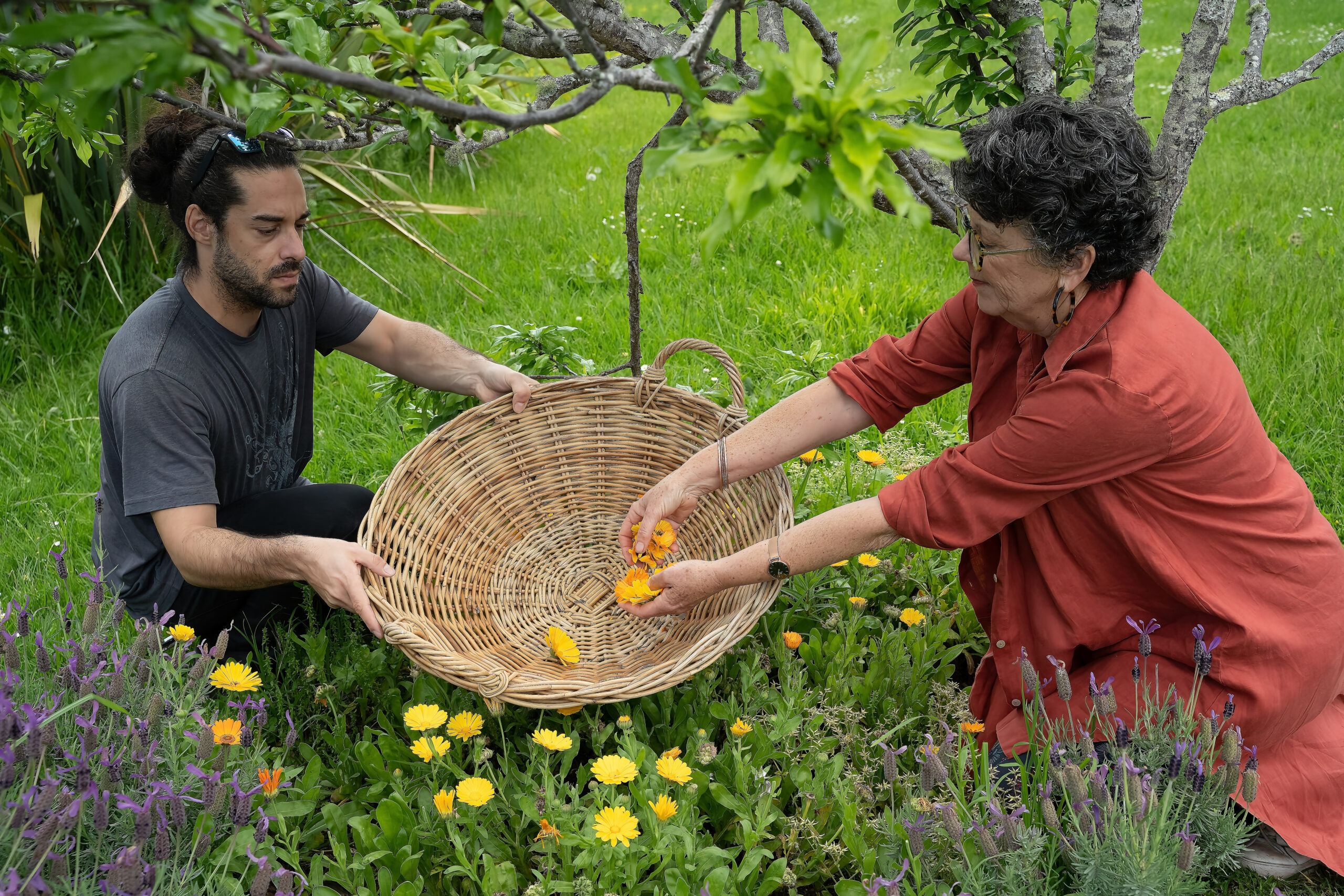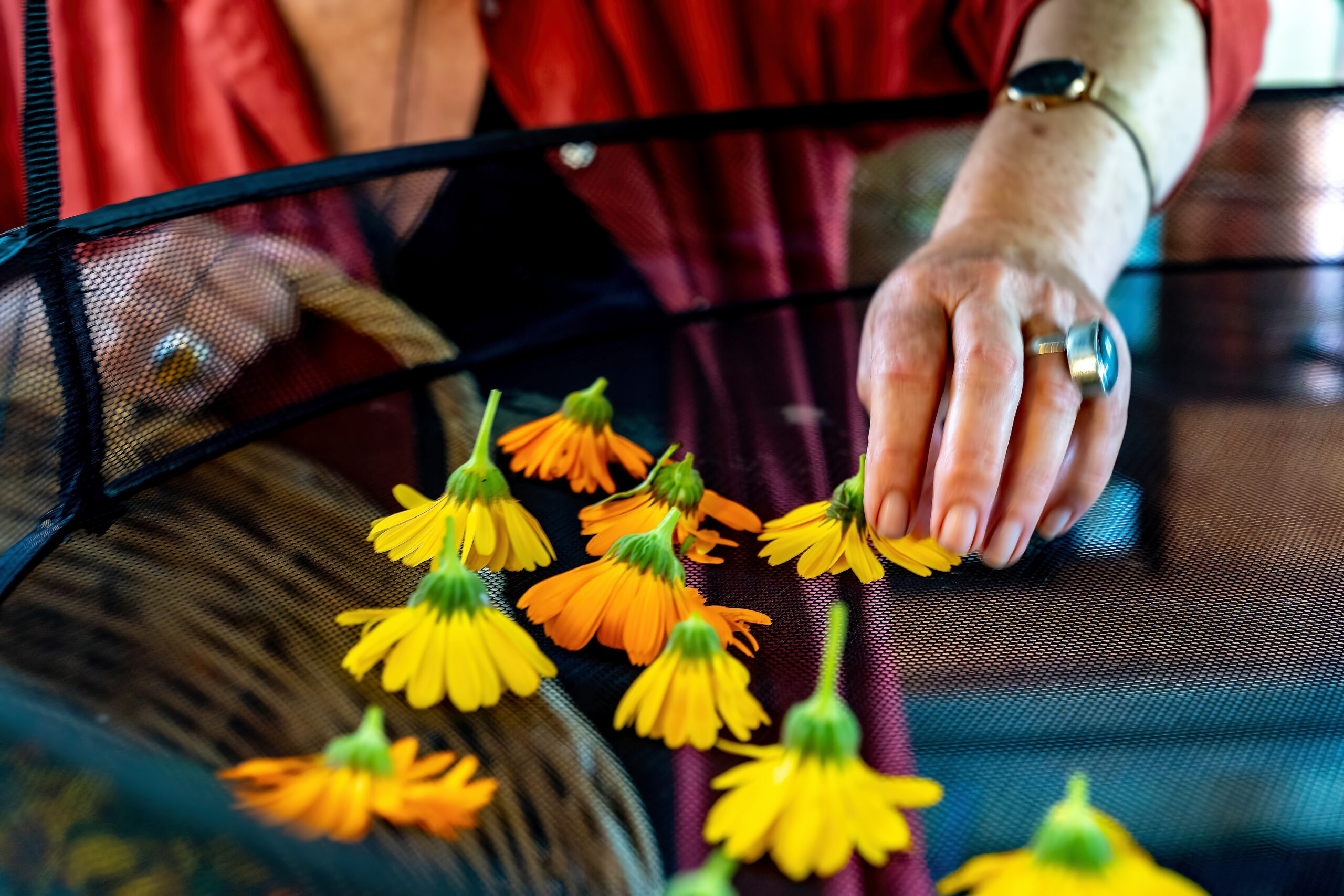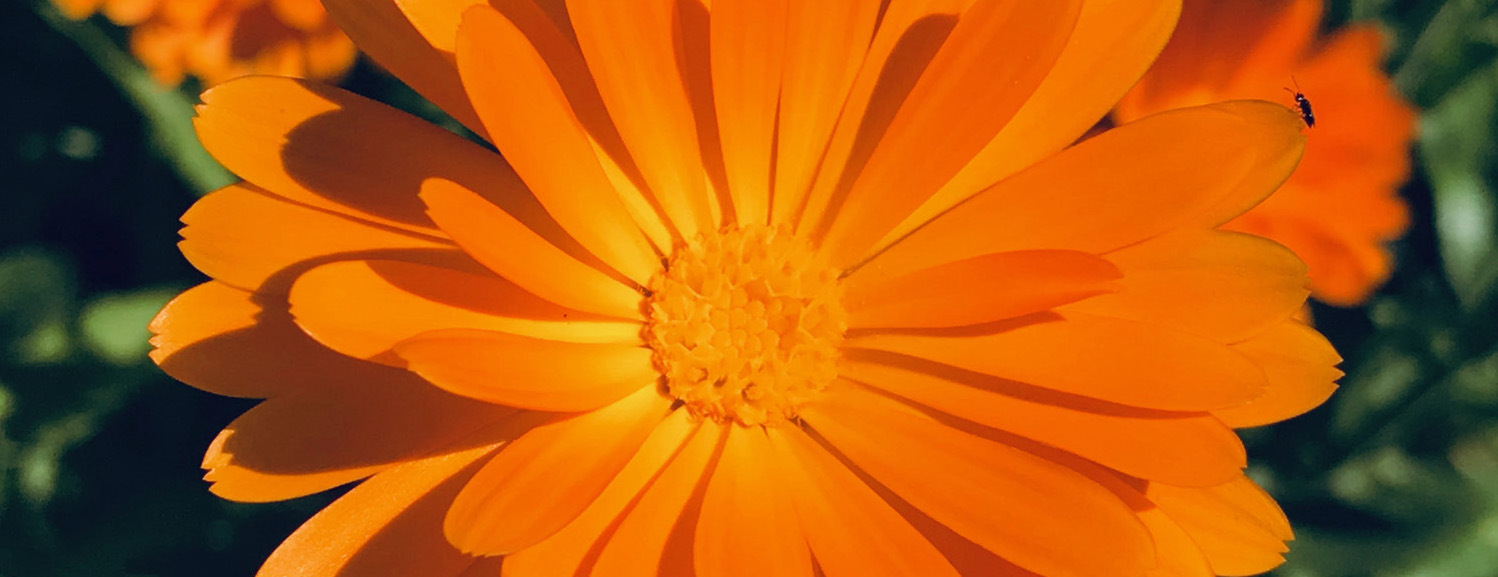Calendula officinalis
ENCYCLOPEDIA BOTANICA / CALENDULA
Grown for beauty, medicine and food, calendula flowers are a visually uplifting display of intense yellow or orange-gold blooms. Calendula is subtly scented, but powerfully coloured, and in the Lab it’s most often used as an infused oil, or in herbal teas.
Description & Habitat
This colourful member of the daisy family (Asteraceae) is easy to grow as it readily self-seeds, blooming year after year. Calendulas are native to the Mediterranean, but their hardiness and popularity mean these flowers are now common in most temperate climates. The plant gets its name from the Latin calendae meaning ‘little calendar’ or ‘little clock’, as in many climates it can flower all year-round.
Identification tips: Calendula officinalis is also commonly known as pot marigold (as it’s often added to the pot or salad bowl), and is not to be confused with true marigold—Tagetes minuta. There are many members of the genus Calendula but it is Calendula officinalis that has been used medicinally for centuries. Look for the deep orange flowers with a dark brown centre.
Parts used: The whole flowers and petals are used, as well as the sticky calyx. This botanical is used both fresh and dried.
Harvesting: Harvest the flowers when the dew has dried. To dry whole flowers, lay them out face-down on mesh, and ensure good airflow, and ensure they’re not touching each other. The whole flowers take about 7–10 days to dry (petals will dry more quickly). Make sure they are thoroughly dried before storing, otherwise they will become mouldy. Or you can choose to pluck the petals and lay out to dry in a well-ventilated, dry space with no direct sunlight. This way the colour—with its rich load of antioxidants—will stay intact. Once the petals or flowers lose their colour and become faded they lose their aroma, flavour and potency.
If you are purchasing dried calendula, look for a product with good colour. But if you don’t already have calendula in your garden, you should try growing your own. The plants germinate easily from seed, and will continue to self-seed with little to no help. Calendula can be grown in pots and small gardens as well as large, open and wild spaces.

Harvesting calendula

Drying calendula
Aroma & Flavour Profile
Floral orange notes (as opposed to orange fruit), with a green herbaceousness and slightly nutty finish. Tasting raw flowers will often leave a slightly bitter promise on your tongue and a dry mouthfeel. As with all botanicals, we suggest tasting yourself. Select a flower, and if it’s a big one, just take a bite—making sure you get some calyx as well. Gently masticate in your mouth letting your saliva flow and coat it. Breathe out and just relax. Let the images, memories and sensations flow. This way of experiencing a plant is highly subjective and different for everyone. Compare the taste of fresh v dried yourself also, as it will inform the ways you’d like to use it.

Recommended techniques
• Tincture • Infusions (teas) • Infused oil • hydro distilling • CO2 extraction •
Uses
Infused oil
To make an active golden infused oil, macerate the flowers and or petals in the oil. Jeanne Rose has an excellent article on how to make calendula oil and how to use this wonderful flower here. This can then be used in antiseptic and anti-inflammatory balms and as a moisturizing, healing oil or added as an active ingredient to lotions and skin care emulsions. With beeswax and used as a balm classic home-herbal family first aid kit.
Tinctures
When you pick a flower, you’ll notice the sticky texture of the petals and especially on the green involucres (or base) of the flower. This sticky resin is not soluble in water, but is soluble in both oil and alcohol with an ABV of 80% and higher. Calendula has been used as a soothing, anti-inflammatory, and antiseptic wound healing salve for centuries, and many preparations utilise calendula tincture or infused oil. The infused oil has a very dark orange colour, a herbaceous daisy-like aroma and is bitter to take—used by herbalists.
Culinary
The flowers are edible—just pick the fresh petals from the calyx. They add vibrant colour to salads and when decorating cakes—and being rich in antioxidants they add another layer of nutrients. Freeze small whole flowers in ice cubes (or just the single florets) and use as a garnish in drinks. Historically, calendula was also known as ‘poor man’s saffron’ as it adds a golden tint to oils, vinegars and cream. Pigment from the petals are also used as a dye for fabric, hair and in the pharmaceutical industry.
Spirits
Calendula petals added post distillation will give over the beautiful golden colour to the spirit.
Hydrosol
Many people don’t regularly use calendula for hydro-distilling, as calendula’s sticky resin isn’t soluble in water, and won’t be part of a hydrosol. Instead, they may prefer to use it primarily dried in herbal teas, or tinctured and infused in oil to use in balms and creams. However, this is not to say the hydrosol is of no use. For example when making an aqueous cream (one which contained water) you may like to use the calendula hydrosol in the water phase to combine all aspects—the water soluble, as well as the sticky resin and non water soluble parts of the plant that will come over in the oils and the alcohol. If you’re interested in finding out what compounds the hydrosol contains, Ann Harman regularly distils for hydrosol, and has had it tested by GCMS from Circle Institute (see the link below, under GCMS).
Table of GSMS
You can see the main chemical constituents of a classic calendual hydrosol from the Circle H Institute here.
Essential Oil
Calendula doesn’t readily produce an essential oil when distilled, so products sold as ‘calendula essential oil’ are often likely to be an infused fixed oil, so it pays to check. Some distillers do report success distilling calendula for essential oil, but yields are very small. CO2 extraction can be used to produce a waxy, orange-coloured extract.
Perfumery
Calendula officinalis is not widely used in perfumery. There is some confusion though, and typically, it was involved with naming as people often call calendula ‘marigold’. Tagetes Patula, commonly known as ‘French Marigold’ does produce an essential oil and is and is used in French perfumery.



